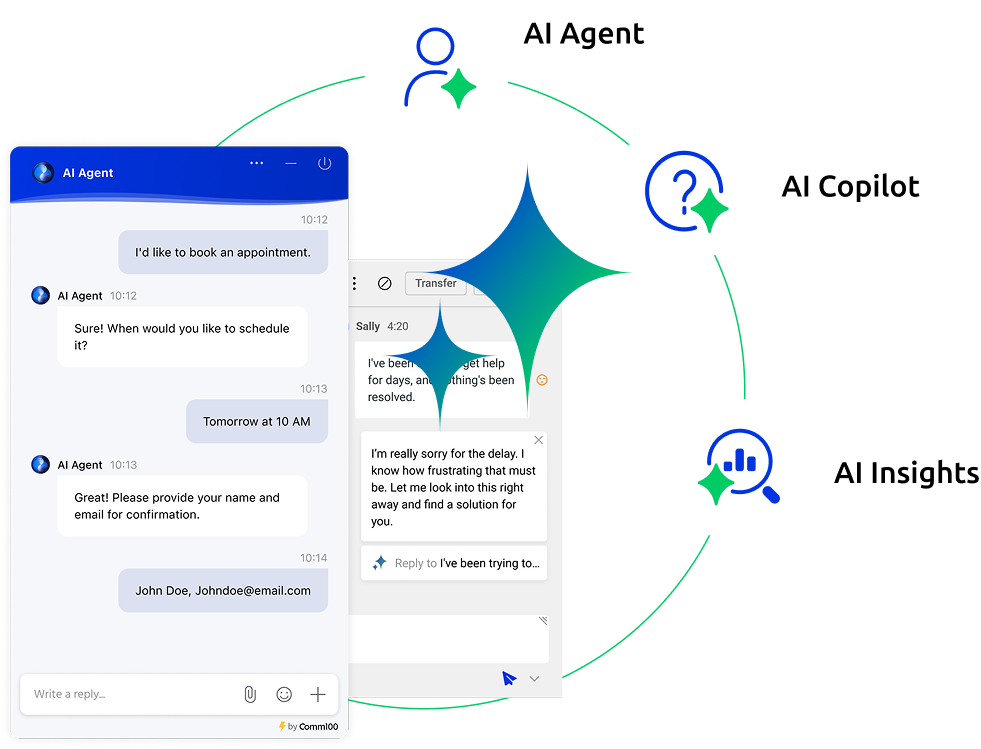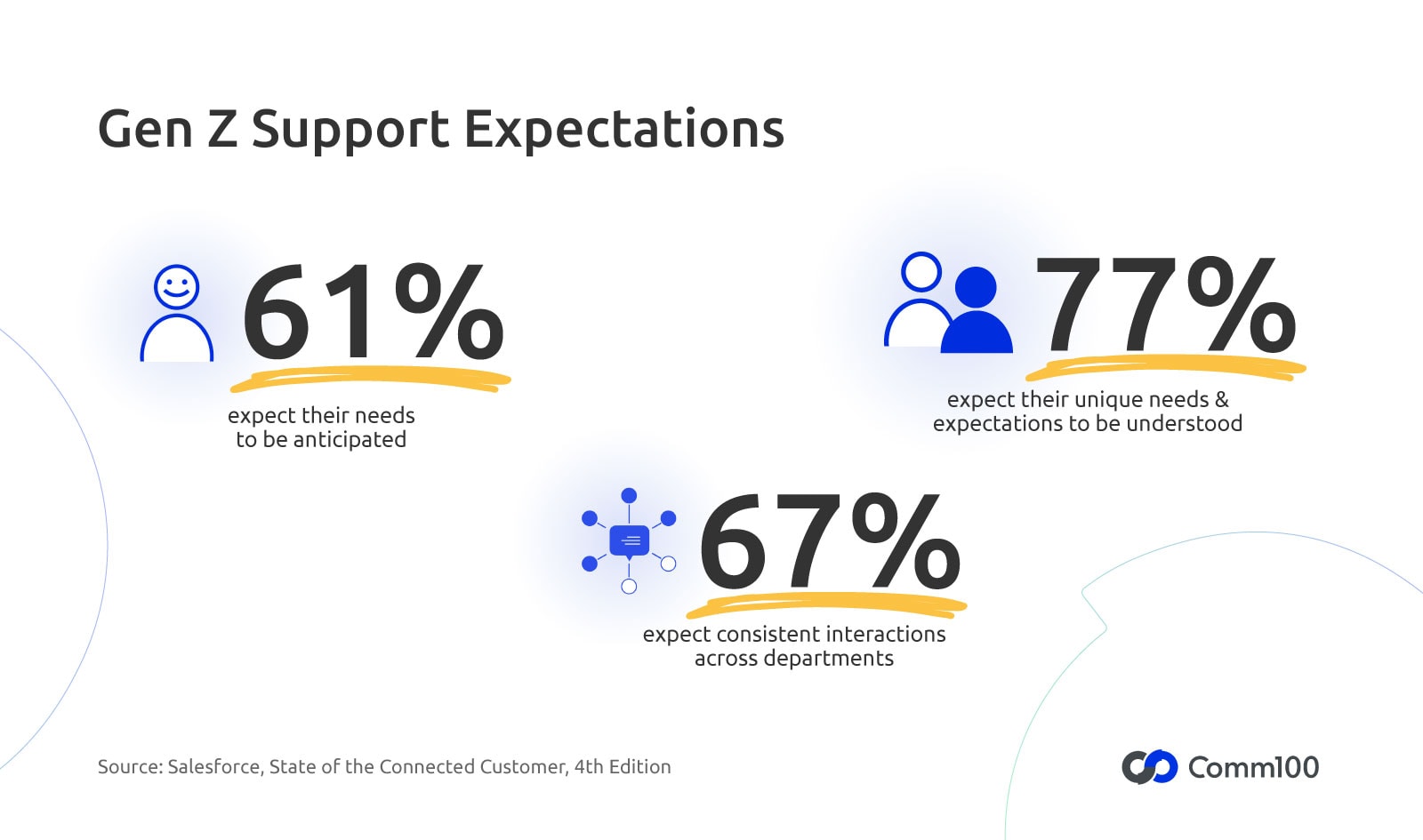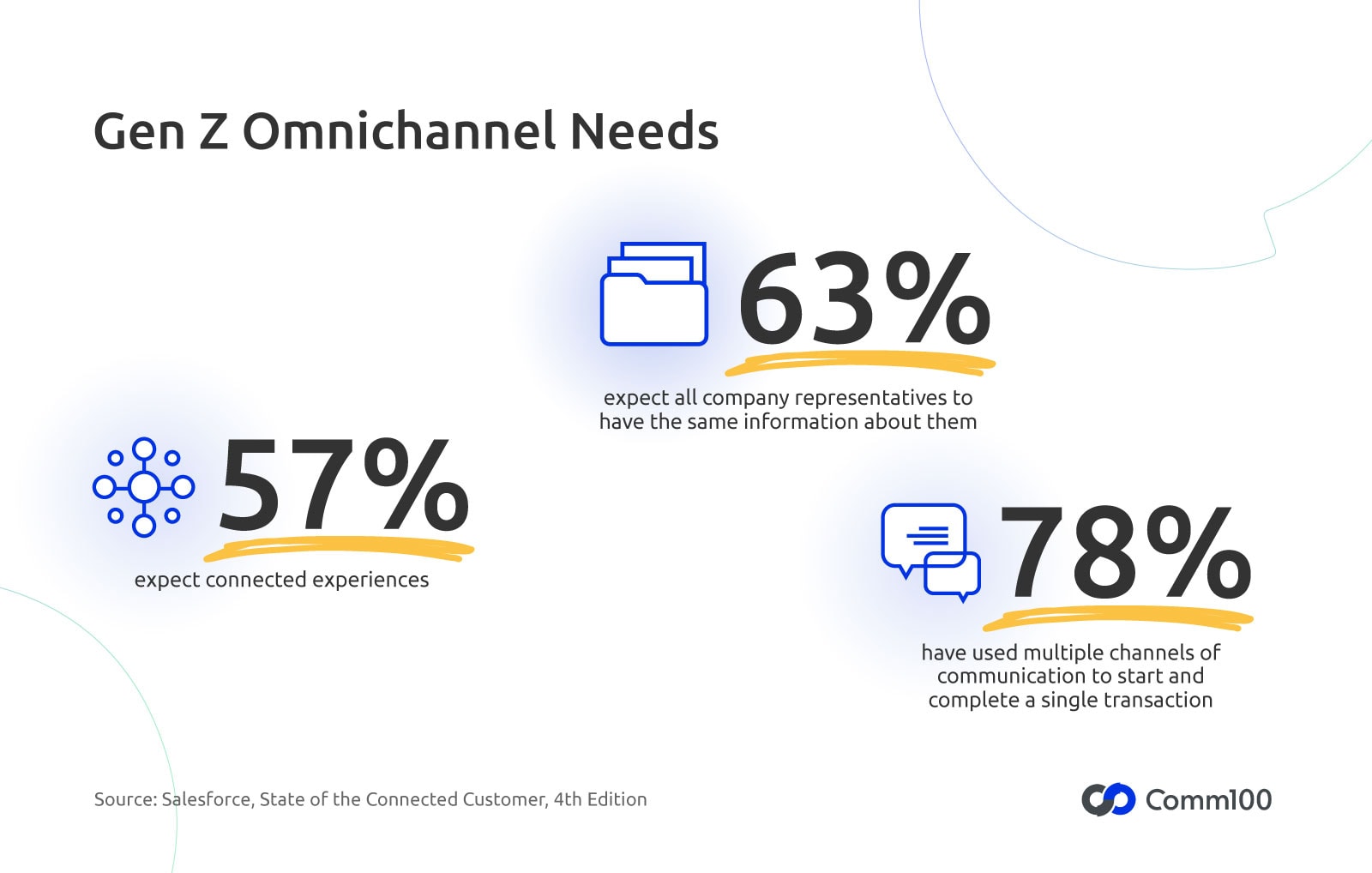Live webinar: Cut costs, grow revenue - Transform CX with the new Comm100 AI trifecta ✨
Register nowLive webinar: Cut costs, grow revenue - Transform CX with the new Comm100 AI trifecta ✨
Register nowToday’s students are CX-indulged.
Thanks to technology, Gen Z (born 1997-2012) have grown up surrounded by first-class customer experience, enjoying exceptional levels of convenience, speed, and personalization. From Amazon’s same day delivery to UberEat’s seamless takeaway offering, no demographic has ever had it so good.
While this is great for Gen Z, it may not be such welcoming news for universities and colleges. Being accustomed to such high levels of CX, students now expect the same support from every organization they interact with – and higher education doesn’t escape this.
Schools must improve student support in higher education to meet these expectations. Without doing so, they risk damaging every stage of the student lifecycle, from admissions to graduation rates. On the other hand, by understanding the importance of student support services and matching these expectations, schools can improve everything – from enrolment and engagement, through to satisfaction and drop-out rates.
This guide will take you through the key student expectations and how to improve student support services so you can meet these demands. Alternatively, find out how Comm100’s digital communication platform achieves this too.

The New Comm100 AI Trifecta – Driving Smarter, Deeper Customer Relationships
Join us live – Learn how AI Agent, AI Copilot, and AI Insights work together to transform CX.

Student support services play a critical role in enhancing the educational experience and promoting the success of students. These services encompass a broad spectrum of programs and resources designed to address academic, emotional, social, and financial challenges that students may face. Here are several key aspects highlighting the importance of student support services:
The importance of student support services can’t be understated. By addressing the holistic needs of students, support services play a fundamental role in fostering a supportive and inclusive educational environment. They not only contribute to academic success but also to the development of well-rounded individuals who are prepared to face life’s challenges and contribute positively to society.

Student support expectations have never been higher. Learn how your school can meet these expectations and improve engagement and satisfaction.
When it comes to support expectations, students hold a high bar. With technology at their fingertips, they have become accustomed to seamless digital experiences and so expect this same experience in customer service and support. Here are the 4 key expectations Gen Z have when it comes to support:


The importance of student support services across the board can’t be stressed enough. The quality of student support can be the decider for admissions to graduation rates and everything in between. However, students’ high expectations have exposed gaps in the student support service capabilities of many universities and colleges.
Most leaders of student support in higher ed recognize some, if not all, of the above, in their own operations, and realize they are failing to provide the student support that is expected of them. In an Academic Impression’s survey, only 8% of higher education professionals from 79 colleges and universities graded their institution’s student support with an ‘A’. So what are the key ways to improve higher education customer service?

When asking how to improve student support services, you must begin by understanding how students interact. Gen Z are undoubtedly digital-first, so it shouldn’t come as a surprise that they are also digital-first when it comes to student support service. To provide students with the support they demand, schools must prioritize digital communication channels. But before we dig into the benefits of digital support, it’s important to note the role of telephone within this.
Across every age demographic, and especially Gen Z, there is a move away from phone support and towards digital communication. In fact, 60% of Gen Z say that they ‘hate calling people’. This is in part due to the desire for convenience. Phone is a notoriously high-friction channel, forcing callers to be put on long hold times and repeatedly passed between agents.

In our latest higher education student survey, we asked current students what the most important support factors were to them. Digital communication was ranked highest, as the data shows below.

Here are the key digital channels and technology that schools must offer to meet support expectations:

Student support expectations have never been higher. Learn how your school can meet these expectations and improve engagement and satisfaction.
The solution: Live chat
71% of 16-24 year-olds believe that CX can be drastically improved by quick responses.
When asking how to improve student support services, live chat often comes to the forefront. The speed at which students can ask a question and get a fast answer is key to the popularity of live chat in higher ed. Students have grown up in a digital world that has created a desire for instant gratification, and this has seeped into customer service and support. The instancy of live chat messaging caters to this behavioral expectation better than any other channel.
Grown up surrounded by technology and spending 74% of their free time online, live chat is also an incredibly convenient channel for students to reach out via.
“Our students are mostly 17, 18 or 19 years old, and they naturally find live chat very easy to use. It’s also very quick for them – they can hop on a chat, ask us a question, and have their answer in a minute – all from their mobile device. It’s the perfect channel to help us engage with them and give them the support they need.”
Derek Gaucher, Coordinator of IT Solutions, Dawson College
Read the full story: Dawson College Holds Virtual Open House with Live Chat & Video Engagement
To improve speed further, you can integrate a knowledge base within the live chat solution. This allows the agent to quickly search for the information they need within the console, without needing to switch screens or platforms. AI-powered virtual assistants take this a step further. By monitoring live chat conversations in real-time, these AI tools automatically find and provide answers for the agent to send. This reduces (or even eliminates) the time spent looking for information, as well as typing out the answer.
The need for speed is driving students away from phone (and even email in some cases), and towards the instancy of live chat. As a result, live chat is becoming an essential tool for student support services in higher education.
The solution: Chatbots
99% of students think it’s at least somewhat important for schools to offer 24/7 support.
Live chat is the best channel to connect with students, but few schools can afford to provide this support 24/7. So, what can you do to be there for those students, night owls, and weekend academics who want to connect with you out of your typical customer service hours?
AI chatbots are the perfect answer to this expectation for round-the-clock student support in higher ed. When your team is offline, a chatbot can step in to answer students’ questions – all without any human supervision. Chatbots that are powered by AI can manage even more queries as they are able to understand intent, enabling them to respond to more types of questions, more effectively. Better still, students are open to using bots. In our higher education survey, 95% of students said they are at least somewhat open to receiving support from a chatbot. No student support services in higher ed can live without a bot if they want to meet their students’ needs.
“The bot has allowed us to not only effectively manage the increase in chat volume, but it’s also saved us a considerable amount of money by not having to hire a lot more agents.”
Richard Branson, COO of Tangerine
Read the full story: Comm100 Chatbot Resolves 91% of Assigned Live Chats for Tangerine
Here are just a handful of chatbot use cases to improve student support services:
When choosing the best chatbot for your school, it’s important to understand what it is that you want your bot to achieve, including being realistic about the scope of your bot. While AI chatbots can handle a lot of queries and tasks, you should never expect a bot to handle everything – all teams of student support in higher ed face questions that need a ‘human touch’.
The solution: Social media
97% of students use social media, with those at university the most active of all students.
It won’t come as a shock to hear that students spend a lot of time on social media platforms. However, despite schools knowing this, student support in higher education is often neglecting this channel. While 98% of schools use social media, the majority use it to improve brand awareness, image, and engagement, while missing out on one of its most important uses – as a support channel.
By offering social media in a higher education as a support channel, institutions can connect with students on the channels that they use most – be that Facebook, Instagram, Twitter, WeChat, or WhatsApp. And what’s more, you can connect all of these platforms with the other key digital channel for an efficient and seamless experience. More on this in the next point.
The solution: Omnichannel student support
77% of students want support staff to remember previous conversations they’ve had.
So far we have explained how students want to be able to connect with schools across a variety of digital channels – be that live chat, chatbot, social media, and email too- and the importance of student support services catering to this expectations. Many schools would shudder at the mere thought of offering all of these channels, worrying that some, if not all, of the following are true:
All of the above would be true, if it wasn’t for Comm100’s omnichannel platform. This platform brings every digital channel together into one easy-to-use, unified agent console. Moreover, all the data within each channel is brought together too. This eliminates channel siloes and empowers agents to provide helpful and personalized support that students expect. In fact, 74% of Gen Z say they ‘prefer personalized products or services’, yet only 32% feel like they are being ‘treated as a unique individual’.

With every channel connected, it means:
With an omnichannel platform, agents can provide the connected experience that 57% of students expect and treat every student like an individual.
To level-up your student support services in higher education and match your students’ expectations, book a demo with Comm100’s specialists.
With live chat, messaging, voice, bots and automation all wrapped up in a secure, personalized and AI-powered solution, Comm100 fits your needs now, and later. Join the likes of Stanford University, McMaster University, California Southern University, and transform student support services in your school.

Book a 30-minute, obligation-free demo with our specialists to discover how Live Chat, AI Agent, AI Copilot and AI Insights can benefit your business.
There’s a lot more where this came from!
Get our monthly customer service news and best practices update delivered to your inbox.

Article by
Kate is the Content Marketing Specialist at Comm100. She has extensive experience in content creation for technology companies across the world, including the UK, Australia and Canada. She specializes in B2B messaging, branding and soccer trivia.